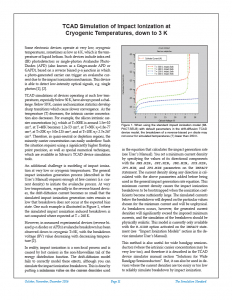TCAD Simulation of Impact Ionization at Cryogenic Temperatures, down to 3 K
Some electronic devices operate at very low, cryogenic temperatures, sometimes as low as 4 K, which is the temperature of liquid helium. Such devices include infra-red (IR) photodetectors or single-photon Avalanche Photo-Diodes (APD) (also known as a Geiger-mode APD or GAPD), based on a reverse biased p-n junction in which a photo-generated carrier can trigger an avalanche current due to the impact ionization mechanism. This device is able to detect low-intensity optical signals, e.g. single photon [1], [2].
TCAD simulations of devices operating at such low temperatures, especially below 50 K, have always posed a challenge. Below 50 K, carrier and ionization statistics develop sharp transitions which cause slower convergence. As the temperature (T) decreases, the intrinsic carrier concentration also decreases. For example, the silicon intrinsic carrier concentration (ni), which at T=300K is around 1.5e+10 cm-3, at T=40K becomes 1.2e-53 cm-3, at T=30Kni=1.8e-77 cm-3, at T=20K ni= 5.0e-125 cm-3, and at T=10K ni= 2.7e-267 cm-3. Therefore, in quasi-neutral or depletion regions, the minority carrier concentration can easily underflow. Such the situation requires using a significantly higher floating point precision, as well as special numerical techniques, which are available in Silvaco’s TCAD device simulation tools.



